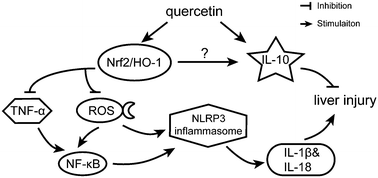当前位置:
X-MOL 学术
›
Food Funct.
›
论文详情
Our official English website, www.x-mol.net, welcomes your
feedback! (Note: you will need to create a separate account there.)
Targeting heme oxygenase-1 by quercetin ameliorates alcohol-induced acute liver injury via inhibiting NLRP3 inflammasome activation
Food & Function ( IF 5.1 ) Pub Date : 2018-07-09 , DOI: 10.1039/c8fo00650d Shu Liu 1, 2, 3 , Lei Tian 3, 4, 5 , Guangrui Chai 3, 6, 7 , Bo Wen 1, 2, 3 , Bingyuan Wang 1, 2, 3
Food & Function ( IF 5.1 ) Pub Date : 2018-07-09 , DOI: 10.1039/c8fo00650d Shu Liu 1, 2, 3 , Lei Tian 3, 4, 5 , Guangrui Chai 3, 6, 7 , Bo Wen 1, 2, 3 , Bingyuan Wang 1, 2, 3
Affiliation

|
Alcoholic hepatitis (AH) is characterized by inflammation and necrosis of liver tissue caused by excessive alcohol consumption and it even causes organ failure sometimes, in which oxidative stress plays an important role. Quercetin is a bioactive flavonoid in the class of polyphenols with a free-radical scavenging ability and anti-inflammatory activity. Recently it has aroused great interest because of its potential benefits in the prevention and intervention of cancer, cardiovascular abnormalities, neurodegenerative diseases, metabolic disorders and liver fibrosis. However, its role in alcoholic liver injury is still unclear and needs to be elucidated. Through database analysis and serum measurements, we found that there was a decline in the level of heme oxygenase-1 (HO-1) in patients with acute alcoholic hepatitis compared to healthy controls. Quercetin could elevate the expression of nuclear factor E2-related factor 2(Nrf2)/HO-1 and ameliorate ethanol-induced acute liver injury in rats. Moreover, this protective effect of quercetin could be diminished when combined with the HO-1 inhibitor ZnppIX which demonstrated a critical role of HO-1 in quercetin's hepatoprotection. The underlying mechanism of quercetin's benefit on the liver may be explained by its anti-oxidant properties and inhibitory effect on the ROS/NF-κB/NLRP3 inflammasome/IL-1β and IL-18 pathway by inducing HO-1. Meanwhile, quercetin also upregulated the anti-inflammatory factor IL-10, while it was found uncorrelated with HO-1 expression. In conclusion, quercetin can preserve the function of the liver in acute alcoholic injury by upregulating the expression of IL-10 and HO-1 and thus inhibiting NLRP3 inflammasome activation and inflammatory factor secretion. In other words, quercetin looks promising as an alternative treatment and HO-1 may be a potential target in the crosstalk of inflammation and oxidative stress in alcoholic liver damage.
中文翻译:

槲皮素靶向血红素加氧酶-1可通过抑制NLRP3炎性体活化来改善酒精引起的急性肝损伤
酒精性肝炎(AH)的特征是过量饮酒引起的肝组织炎症和坏死,有时甚至引起器官衰竭,其中氧化应激起重要作用。槲皮素是多酚类中的一种生物活性类黄酮,具有自由基清除能力和抗炎活性。最近,由于其在预防和干预癌症,心血管异常,神经退行性疾病,代谢紊乱和肝纤维化方面的潜在益处,引起了人们极大的兴趣。然而,其在酒精性肝损伤中的作用仍不清楚,需要阐明。通过数据库分析和血清测量,我们发现与健康对照组相比,急性酒精性肝炎患者血红素加氧酶-1(HO-1)的水平有所下降。槲皮素可以提高核因子E2相关因子2(Nrf2)/ HO-1的表达,减轻乙醇引起的大鼠急性肝损伤。此外,当与HO-1抑制剂ZnppIX结合使用时,槲皮素的这种保护作用可能会减弱,而后者证明了HO-1在槲皮素的肝保护作用中起着至关重要的作用。槲皮素对肝脏有益的潜在机制可以通过诱导HO-1的抗氧化特性和对ROS /NF-κB/ NLRP3炎性体/IL-1β和IL-18途径的抑制作用来解释。同时,槲皮素也上调抗炎因子IL-10,而发现它与HO-1表达无关。综上所述,槲皮素可以通过上调IL-10和HO-1的表达从而抑制NLRP3炎性体的激活和炎性因子的分泌,从而保留肝脏在急性酒精中毒中的功能。换句话说,槲皮素有望作为一种替代疗法,而HO-1可能是酒精性肝损伤中炎症和氧化应激相交的潜在靶标。
更新日期:2018-08-15
中文翻译:

槲皮素靶向血红素加氧酶-1可通过抑制NLRP3炎性体活化来改善酒精引起的急性肝损伤
酒精性肝炎(AH)的特征是过量饮酒引起的肝组织炎症和坏死,有时甚至引起器官衰竭,其中氧化应激起重要作用。槲皮素是多酚类中的一种生物活性类黄酮,具有自由基清除能力和抗炎活性。最近,由于其在预防和干预癌症,心血管异常,神经退行性疾病,代谢紊乱和肝纤维化方面的潜在益处,引起了人们极大的兴趣。然而,其在酒精性肝损伤中的作用仍不清楚,需要阐明。通过数据库分析和血清测量,我们发现与健康对照组相比,急性酒精性肝炎患者血红素加氧酶-1(HO-1)的水平有所下降。槲皮素可以提高核因子E2相关因子2(Nrf2)/ HO-1的表达,减轻乙醇引起的大鼠急性肝损伤。此外,当与HO-1抑制剂ZnppIX结合使用时,槲皮素的这种保护作用可能会减弱,而后者证明了HO-1在槲皮素的肝保护作用中起着至关重要的作用。槲皮素对肝脏有益的潜在机制可以通过诱导HO-1的抗氧化特性和对ROS /NF-κB/ NLRP3炎性体/IL-1β和IL-18途径的抑制作用来解释。同时,槲皮素也上调抗炎因子IL-10,而发现它与HO-1表达无关。综上所述,槲皮素可以通过上调IL-10和HO-1的表达从而抑制NLRP3炎性体的激活和炎性因子的分泌,从而保留肝脏在急性酒精中毒中的功能。换句话说,槲皮素有望作为一种替代疗法,而HO-1可能是酒精性肝损伤中炎症和氧化应激相交的潜在靶标。











































 京公网安备 11010802027423号
京公网安备 11010802027423号